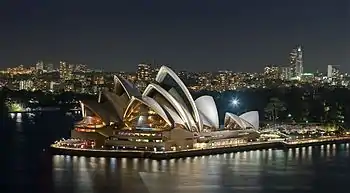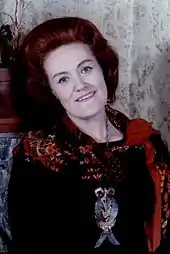Theatre of Australia
Theatre of Australia refers to the history of the performing arts in Australia, or produced by Australians. There are theatrical and dramatic aspects to a number of Indigenous Australian ceremonies such as the corroboree. During its colonial period, Australian theatrical arts were generally linked to the broader traditions of English literature and to British and Irish theatre. Australian literature and theatrical artists (including Aboriginal as well as Anglo-Celtic and multicultural migrant Australians) have over the last two centuries introduced the culture of Australia and the character of a new continent to the world stage.
| Part of a series on the |
| Culture of Australia |
|---|
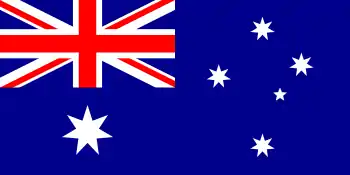 |
| History |
| Languages |
| Cuisine |
| Festivals |
| Sport |
|
Individuals who have contributed to theatre in Australia and internationally include Sir Robert Helpmann, Dame Joan Sutherland, Barry Humphries, David Williamson, Cate Blanchett, Geoffrey Rush, Judy Davis, Jim Sharman, Tim Minchin and Baz Luhrmann. Notable theatrical institutions include the Sydney Opera House, and the National Institute of Dramatic Art in Sydney.
History
Early history

The traditional ceremonial dances of indigenous Australians performed at corroborees comprise theatrical aspects. At a corroboree Aborigines interact with the Dreamtime through dance, music and costume and many ceremonies act out events from the Dreamtime.[1] Corroboree in many areas have developed and adapted, integrating new themes and stories since European occupation of Australia began. Academic Maryrose Casey writes that ‘Australian Aboriginal cultures are probably the most performance-based in the world – in the sense that explicit, choreographed performances were used for a vast range of social purposes from education, through to spiritual practices, arranging marriage alliances, to judicial and diplomatic functions’.[2] Casey suggests that 'corroboree' could also be called 'aboriginal theatre'.[3]
European theatrical traditions came to Australia with European settlement commencing in 1788 with the First Fleet. The first production, The Recruiting Officer written by George Farquhar in 1706, was performed in 1789 by convicts.[4] The extraordinary circumstances of the foundation of Australian theatre was recounted in the 1988 play Our Country's Good by Timberlake Wertenbaker - the participants were prisoners watched by sadistic guards and the leading lady was under threat of the death penalty. The play is based on Thomas Keneally's novel The Playmaker.[4]
The Theatre Royal, Hobart opened in 1837 and is the oldest still-operating theatre in Australia.[5] Noël Coward called it a Dream Theatre and Laurence Olivier came to its defence when it was threatened with demolition in the 1940s.[5] The Queen's Theatre, Adelaide opened with Shakespeare in 1841 and is today the oldest theatre on the mainland.[6] The Melbourne Athenaeum was founded in 1839 as the Melbourne Mechanics' Institute, and its theatre in its present form was created in 1921.[7]
The Australian gold rushes beginning in the 1850s provided funds for the construction of grand theatres in the Victorian style. A theatre was built on the present site of Melbourne's Princess Theatre in 1854.[8]
Post-federation

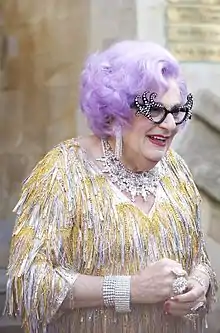
After federation in 1901, theatre productions embodied the sense of national identity that had tormented in Australian literature since the 1890s. On Our Selection (1912)[9] by Steele Rudd told of the adventures of a pioneer farming family and became popular and was adopted to film.
His Majesty's Theatre, Perth opened in 1904. The building remains a rare example of Edwardian theatrical architecture in Australia.[10] Sydney's grand Capitol Theatre opened in 1928 and after restoration remains one of the nation's finest auditoriums.[11] The State Theatre (renamed the Forum in 1963) and the Regent Theatre both opened in Melbourne in 1929, originally as cinemas.
During the 1940s, John Antill composed the music for his Corroboree ballet based on the Aboriginal corroboree. The production was first performed in 1946 and toured Australia during the 1950s and featured on the schedule of Queen Elizabeth II's first Royal Tour of Australia in 1954. It represents an early example of the fusion of Western and Aboriginal theatrical forms in Australia – now regularly expressed, as seen in the work of the Bangarra Dance Theatre.[12][13]
In early 1955, the Union Theatre Repertory Company invited a young Barry Humphries to tour Victoria with a production of Twelfth Night directed by Ray Lawler. On tour, Humphries gradually invented the character of Edna Everage as part of the entertainment for the actors during commutes between country towns, imitating the Country Women's Association representatives who welcomed the troupe in each town.[14] By night Lawler worked on a new play, Summer of the Seventeenth Doll, his tenth but most acclaimed work. Both creations represented historic milestones in Australian theatre. Summer of the Seventeenth Doll was the first Australian play produced by the MTC and portrayed resolutely Australian characters and went on to international acclaim. At Lawler's suggestion, Mrs Everage made her first appearance in a Melbourne University's UTRC revue at the end of 1955, as the city prepared for the 1956 Summer Olympic Games. The sketch involved a houseproud "average housewife" offering her Moonee Ponds home as an Olympic billet.[15] Humphries left for London in his early 20s and enjoyed success on stage, including in Lionel Bart's musical, Oliver!. His satirical stage creations – notably Dame Edna and later Les Patterson – became Australian cultural icons. Humphries also achieved success in the US with tours on Broadway and television appearances and has remained a stalwart of British and Australian theatre and been honoured in both nations.[16]
Growth of non-commercial theatre
The Melbourne Theatre Company, originally the Union Theatre Repertory Company, formed in 1953, is Australia's oldest professional theatre company. Over the years, MTC has championed Australian writing, introducing the works of writers such as Alan Seymour, Vance Palmer, Patrick White, Alan Hopgood, Alexander Buzo, David Williamson, John Romeril, Jim McNeil, Alma De Groen, John Powers, Matt Cameron, Ron Elisha, Justin Fleming, Janis Bolodis, Hannie Rayson, Louis Nowra, Michael Gurr, Jack Davis, Michael Gow and Joanna Murray-Smith and many others to mainstream Melbourne audiences. In The One Day of the Year Alan Seymour studied the paradoxical nature of the ANZAC Day commemoration by Australians of the defeat of the Battle of Gallipoli.
The National Institute of Dramatic Art was established in Sydney in 1958. This institute has since produced a list of famous alumni including Cate Blanchett, Toni Collette, Mel Gibson and Baz Luhrmann.[17]
The Australian Ballet was founded by the English ballerina Dame Peggy van Praagh in 1962. It is Australia's foremost classical ballet company and is today recognised as one of the world's major international ballet companies.[18] It is based in Melbourne and performs works from the classical repertoire as well as contemporary works by major Australian and international choreographers. As of 2010, it was presenting approximately 200 performances in cities and regional areas around Australia each year as well as international tours. Regular venues include: the Melbourne Arts Centre, Sydney Opera House, Sydney Theatre, Adelaide Festival Centre and Queensland Performing Arts Centre.[19]
From the 1960s, major cities across Australia developed new government-owned performing arts centres, often housing not-for-profit theatre, opera and dance companies. Examples include the Canberra Theatre Centre, the Sydney Opera House, Arts Centre Melbourne, the Adelaide Festival Centre and the Queensland Performing Arts Centre in Brisbane. Most major regional centres and many outer metropolitan areas have a professional-standard performing arts centre typically run by the local council, either newly built such as the Riverside Theatres Parramatta, Wagga Wagga Civic Theatre or the Frankston Arts Centre, or a refurbishment of a heritage theatre or cinema such as the Newcastle Civic Theatre, the Theatre Royal, Hobart or the Empire Theatre, Toowoomba.
With the completion of the Adelaide Festival Centre in 1973, Sir Robert Helpmann became director of the Adelaide Festival of Arts.[20][21]
The new wave of Australian theatre debuted in the 1970s with the works of writers including David Williamson, Barry Oakley and Jack Hibberd. The Belvoir St Theatre established by John Bell and Richard Wherrett originated in Sydney around 1970 and presented works by Nick Enright and David Williamson.
The Sydney Theatre Company was founded in 1978 becoming one of Australia's foremost theatre companies. Players associated with the company include Mel Gibson, Judy Davis, Hugo Weaving, Geoffrey Rush and Toni Collette. It operates from The Wharf Theatre near The Rocks, as well as the Sydney Theatre and the Sydney Opera House Drama Theatre.[22]
In 1979, two impoverished young Sydney actors, Mel Gibson and Geoffrey Rush, shared a flat and co-starred in a local production of Waiting for Godot.[23] Gibson had studied at NIDA and made his stage debut alongside classmate Judy Davis in a 1976 production of Romeo and Juliet. The 1979 Australian film Mad Max carried Gibson to the beginnings of a global film career.[24] Rush joined Jim Sharman's Lighthouse Theatre troupe in the 1980s and built a reputation as one of Australia's leading stage actors before becoming known internationally in film.
Arts Centre Melbourne in the Melbourne Arts Precinct was designed by architect Sir Roy Grounds, the masterplan for the complex was approved in 1960, and construction of the Arts Centre began in 1973. The complex opened in stages, with Hamer Hall opening in 1982, and the Theatres Building opening in 1984. The centre now hosts regular performances by Opera Australia, The Australian Ballet, the Melbourne Theatre Company and Melbourne Symphony Orchestra as well as a large number of Australian and international performances and production companies.[25]
The Belvoir St Theatre was established by John Bell and Richard Wherrett in Sydney around 1970. Construction of the Adelaide Festival Centre was completed in 1973. In the same year, the Sydney Opera House was inaugurated in Sydney – becoming among the most famous theatre buildings in the world.
The Bell Shakespeare Company was created in 1990 by John Bell. The company specialises in the works of William Shakespeare. It is Australia's only national touring theatre company touring each Australian state in each year.[26] A period of success for Australian musical theatre came in the 1990s with the debut of musical biographies of Australian music singers Peter Allen (The Boy From Oz in 1998) and Johnny O'Keefe (Shout! The Legend of The Wild One).
Ngapartji Ngapartji, by Scott Rankin and Trevor Jamieson, recounts the story of the effects on the Pitjantjatjara people of nuclear testing in the Western Desert during the Cold War. It is an example of the contemporary fusion of traditions of drama in Australia with Pitjantjatjara actors being supported by a multicultural cast of Greek, Afghan, Japanese and New Zealand heritage.[27]
Eminent contemporary Australian playwrights include David Williamson, Alan Seymour, the late Nick Enright and Justin Fleming.[28]
Theatre today
Theatre in Australia today includes a diverse range of performances of different scale and contexts.
Commercial theatres like the Lyric, Capitol and Theatre Royal in Sydney and the Regent, Princess, Her Majesty's and Comedy in Melbourne, and other major venues in these and other cities, host Australian productions of popular musicals and other large-scale events. Resident professional theatre companies in Sydney (Sydney Theatre Company, Belvoir, Griffin, Ensemble), Melbourne (Melbourne Theatre Company, Malthouse), Brisbane (Queensland Theatre, La Boite), Perth (Black Swan), Adelaide (State Theatre Company of South Australia), and some other cities on a smaller-scale, produce mainstage seasons of Australian and international plays and, occasionally, musicals.
Some professional companies focus on particular genres like classical theatre (Bell Shakespeare), theatre for young people (Windmill, Barking Gecko, Patch, Arena, Monkey Baa), music theatre (The Production Company, Harvest Rain) or circus and physical theatre (Circa, Circus Oz). Other companies specialise in areas such as artists with disability (Back to Back), Indigenous artists (see below) or specific communities (Urban Theatre Projects, Big hART).
Performing arts centres across the country like the Sydney Opera House, Arts Centre Melbourne, Queensland Performing Arts Centre, Adelaide Festival Centre produce, present or host Australian and international theatre productions of various kinds. Venues in smaller cities like the Theatre Royal Hobart, The Arts Centre Gold Coast, Darwin Entertainment Centre or Geelong Performing Arts Centre, or outside the CBD of major cities like Frankston Arts Centre, Riverside Theatre Parramatta or Sunnybank Performing Arts Centre, also present seasons of touring productions. Non-traditional spaces Carriageworks in Sydney and Arts House in Melbourne have a focus on contemporary and experimental works. Independent and fringe theatre is fostered by venues such as La Mama and Theatre Works in Melbourne and the Old Fitz in Sydney.
Opera companies include Opera Australia which performs major seasons in Sydney and Melbourne, and West Australian Opera, Opera Queensland, State Opera of South Australia and Victorian Opera based in individual states. Sydney's Pinchgut Opera, for baroque and early classical works, and Sydney Chamber Opera, for twentieth century and contemporary works, perform opera in chamber settings.
The national Helpmann Awards are the major live performance awards in Australia. Major cities also have their own theatre awards, such as the Sydney Theatre Awards, Melbourne's Green Room Awards and Brisbane's Matilda Awards.
Publishers of Australian playscripts include the non-profit Australian Script Centre, Currency Press, Playlab Press and Full Dress Publishing.
Indigenous theatre
In the late 1960s and early 1970s, street theatre, guerrilla theatre and other performances put on by the Aboriginal community were used as a form of political protest.[29] Melbourne's Nindethana Theatre was Australia's first Aboriginal theatre company, co-founded by Bob Maza and Uncle Jack Charles.[29] Maza also helped set up National Black Theatre in Redfern, Sydney,[30] both in the 1970s. Playwrights such as Kevin Gilbert, Jack Davis and Kath Oodgeroo Noonuccal Walker wrote works which were by, about and for Aboriginal people, and Harry and Bindi Williams, Gary Foley and Paul Coe added to the content and drive which helped "Blak" theatre production.[29]
As of 2020 there are several Indigenous theatre companies in existence, such as Yirra Yaakin in Perth, Ilbijerri in Melbourne (led by Bob Maza's daughter, Rachael),[31] and Moogahlin Performing Arts,[32] based in Sydney's Carriageworks. The Bangarra Dance Theatre is known worldwide, BlakDance is another pathway for Indigenous dancers, and Marrugeku, "Australia's Leading Indigenous Intercultural Dance Theatre", has bases on both Sydney Carriageworks and in Broome, Western Australia.[29] [33]
The Aboriginal Centre for the Performing Arts in Brisbane provides a pathway for young Indigenous performers. Writer/performers such as Nakkiah Lui[31] and Leah Purcell,[34] and others continue to produce work for stage.
Theatre companies
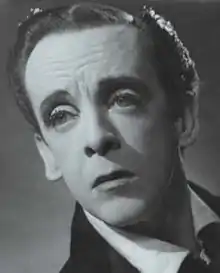
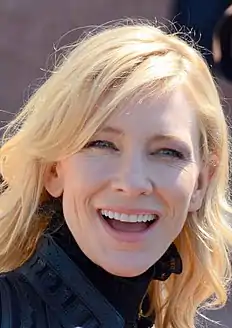
Plays and theatre
- Back to Back Theatre
- BakeHouse Theatre
- Bell Shakespeare Company
- Black Swan Theatre Company
- Brink Productions
- Belvoir - based at the Belvoir St Theatre in Sydney.
- Factory Space Theatre Company (Sydney)
- Griffin Theatre Company
- La Boite Theatre
- La Mama Theatre (Melbourne)
- Malthouse Theatre
- Melbourne Theatre Company
- Northern Rivers Performing Arts (NORPA)
- Queensland Theatre - the oldest continuous professional theatre company in Queensland.
- State Theatre Company of South Australia
- Sydney Theatre Company
- Twelfth Night Theatre
- Tropic Sun Theatre Company
- Windmill Performing Arts
Musical theatre
Circus and physical theatre
- Circa, based in Brisbane
- Circus Oz
- Kage Physical Theatre
- Legs On The Wall
- Gravity and Other Myths
Opera companies
Performing arts festivals
Major performing arts festivals
Fringe festivals
Theatre education
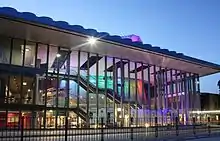
- Aboriginal Centre for the Performing Arts
- Australian Institute of Music - Dramatic Arts
- National Institute of Dramatic Art (NIDA)
- Western Australian Academy of Performing Arts (WAAPA)
- Victorian College of the Arts (VCA)
- National Theatre Drama School (The "Nash")
- National Institute of Circus Arts (NICA)
- Adelaide College of the Arts
- Australian Institute of Music
- CQUniversity's Central Queensland Conservatorium of Music, Mackay
Awards and competitions
- Green Room Awards - for Melbourne theatre, opera and dance
- Helpmann Award - national awards for plays, musicals, opera, dance, comedy, cabaret, contemporary music and classical music
- Mo Awards
- Matilda Awards - for Brisbane theatre
- Sydney Theatre Awards - for Sydney theatre
Performing arts publishers
- Australian Script Centre
- Currency Press
- Playlab Press
- Full Dress Publishing
See also
References
- "Australian indigenous ceremony – song, music and dance". Australia.gov.au. Archived from the original on 18 August 2017. Retrieved 18 August 2017.
- M. Casey, "Aboriginal performance as war by other means in the nineteenth century", International Journal of Critical Indigenous Studies, Indigenous Studies Research Network, Vol. 8, No. 2, pp. 2-15, Queensland University of Technology, Brisbane 2015.
- M. Casey, Theatre or corroboree, what’s in a name? Framing Indigenous Australian 19th-century commercial performance practices, in ‘Creating White Australia: new perspectives on race, whiteness and history’, J Carey and C McLisky (eds.), pp. 117 – 132, University of Sydney Press, Sydney 2009.
- "The Recruiting Officer & Our Country's Good - Stantonbury Campus Theatre Company, 2000". Olioweb.me.uk. Retrieved 18 August 2017.
- "Archived copy". Archived from the original on 4 October 2010. Retrieved 29 January 2011.CS1 maint: archived copy as title (link)
- "Archived copy". Archived from the original on 21 February 2011. Retrieved 29 January 2011.CS1 maint: archived copy as title (link)
- "Archived copy". Archived from the original on 17 February 2011. Retrieved 23 February 2011.CS1 maint: archived copy as title (link)
- "Archived copy". Archived from the original on 30 March 2010. Retrieved 23 October 2010.CS1 maint: archived copy as title (link)
- "Archived copy". Archived from the original on 12 May 2013. Retrieved 11 November 2012.CS1 maint: archived copy as title (link)
- "His Majesty's Theatre". Perth Theatre Trust.
- "Archived copy". Archived from the original on 10 February 2010. Retrieved 26 September 2010.CS1 maint: archived copy as title (link)
- "Australia Dancing leaps into Trove - National Library of Australia". Australiadancing.org. Archived from the original on 20 March 2012. Retrieved 18 August 2017.
- "Archived copy". Archived from the original on 18 February 2011. Retrieved 19 October 2010.CS1 maint: archived copy as title (link)
- Humphries, Barry (1992). More Please. Viking. pp. 176–177.
- "The clown prince of suburbia". Theaustralian.com.au. 6 February 2009. Retrieved 18 August 2017.
- "BBC NEWS - Entertainment - The man behind Dame Edna Everage". news.bbc.co.uk.
- "Archived copy". Archived from the original on 20 June 2017. Retrieved 16 August 2017.CS1 maint: archived copy as title (link)
- "Archived copy". Archived from the original on 18 November 2010. Retrieved 19 October 2010.CS1 maint: archived copy as title (link)
- "Archived copy". Archived from the original on 8 October 2010. Retrieved 19 October 2010.CS1 maint: archived copy as title (link)
- "Archived copy". Archived from the original on 29 May 2010. Retrieved 29 January 2011.CS1 maint: archived copy as title (link)
- "Archived copy". Archived from the original on 17 February 2011. Retrieved 29 January 2011.CS1 maint: archived copy as title (link)
- "About". Sydney Theatre Company.
- "BBC News - ENTERTAINMENT - Geoffrey Rush: Full of surprises". news.bbc.co.uk.
- "Archived copy". Archived from the original on 18 January 2012. Retrieved 15 January 2017.CS1 maint: archived copy as title (link)
- "Archived copy". Archived from the original on 1 January 2011. Retrieved 3 November 2010.CS1 maint: archived copy as title (link)
- Bell, John (2004). John Bell : the time of my life. Sydney: Currency Press. ISBN 1-74114-134-6.
- "Review: Ngapartji Ngapartji". Dailytelegraph.com.au. 15 January 2008. Retrieved 18 August 2017.
- "Play search - AustralianPlays.org". australianplays.org.
- "Indigenous performing arts is a testament to collective drive and vision". IndigenousX Showcasing & Celebrating Indigenous Diversity. 24 April 2017. Retrieved 28 August 2020.
- Pollock, Zoe. "National Black Theatre". The Dictionary of Sydney. Retrieved 28 August 2020.
- Reich, Hannah (17 July 2020). "Indigenous theatre leaders on stage representation, storytelling and Australian theatre". ABC News (Radio National: The Stage Show). Australian Broadcasting Corporation. Retrieved 28 August 2020.
- "Moogahlin Performing Arts". Home. 10 July 2020. Retrieved 28 August 2020.
- "about". Marrugeku – Australia's Leading Indigenous Intercultural Dance Theatre. Retrieved 28 August 2020.
- Daley, Paul (21 December 2019). "Leah Purcell on reinventing The Drover's Wife three times: 'I borrowed and stole from each'". the Guardian. Retrieved 28 August 2020.
External links
- AustralianPlays.org - The largest source of Australian playscripts
- The History of Theatre in Australia
- AussieTheatre.com - Australia's number one theatre news site
- Highlights in Australian theatre history at the Australian Culture and Recreation Portal
- RealTime - Australian contemporary arts magazine covering dance, performance, sound/music, visual arts, film and media art
- AusStage, Australian Performing Arts Database, Flinders University, SA
- AusStage, theatre productions, Australian National Identity 1829 - 2012. -database, Flinders University, SA
